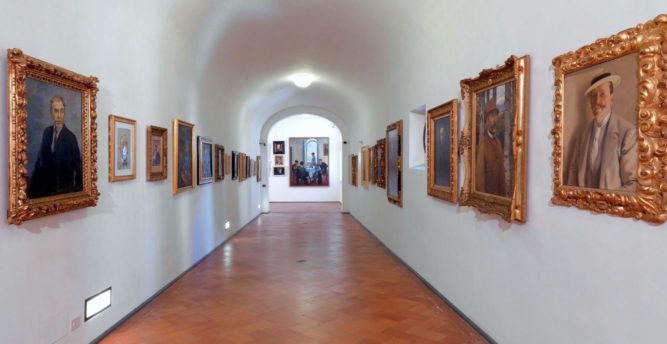The Vasari Corridor’s Restoration & Reopening

Although not as well known as its more famous neighbors the Uffizi Galleries and the Pitti Palace, the Vasari Corridor over Ponte Vecchio is home to one of the world’s most celebrated collections. After five years of being closed to the public, work on the corridor will begin after Easter, in view of a planned reopening date of May 27, 2022. The project will involve restoration as well as the inclusion of safety measures and accessibility for those with disabilities. So far 7 million euros have already been funded; the renovation will cost a total of 10 million.
The Vasari Corridor, which houses the world’s most extensive collection of self-portraits by famous artists throughout the centuries, closed in 2016 due to the lack of exits and fire safety precautions with a plan to begin construction in 2021. Erik Schmidt, the Director of the Uffizi Galleries, explains the particular significance of the inauguration date: it would be the anniversary of the 1993 via dei Georgofili bomb blast which saw damages to the corridor and paintings in the Uffizi, as well as the death of five people at the hands of the mafia. Schmidt explains the reopening of the Vasari Corridor is also a sign of hope after a long period of closed art institutions due to the pandemic.
Built in 1565 by Giorgio Vasari from whom the corridor gets its name, the landmark was constructed on behalf of Grand Duke Cosimo de’ Medici for easy access from the Palazzo Vecchio to the Pitti Palace. The corridor passes above the Arno River as well as has a balcony onto the Santa Felicita church. Cardinal Leopoldo de’ Medici began the collection which now has over 1,300 portraits. Artists including the Carracci brothers and followers of Caravaggio, Rembrandt, Rubens, Lorain, Canaletto, Frespi, Magnasco, Liotard, Chardin, and Goya converted the one-kilometer (a little over a half mile) passageway into an official gallery displaying portraits of Andrea del Sarto, Gian Lorenzo Bernini, Diego Rodriquez de Silva y Velazquez, Antonie Van Dyck, Rosalba Carriera, Jean-Etienne Liotard, Antonio Canova, Auguste-Dominique Ingres, Giovanni Fattori, Giacomo Balla, Gino Servini, and Marc Chagall.
By 2022, the improved corridor will guarantee complete accessibility with ramps, platforms, and lifts which will allow easy access to disabled visitors so all may enjoy the panoramic walk overlooking the Ponte Vecchio, Pitti Palace, and the Boboli Gardens. There will also be bathrooms, air conditioning, an environmentally friendly heating system that will use underground geothermal probes, and LED lighting. In addition to these necessary structural changes, the 73 windows which line the walkway will reopen after being in the dark to protect the paintings. The three larger windows in the Corridor will reopen as well; these windows were ordered to be built by Benito Mussolini for Hitler’s visit to Florence.
Two memorials will also be included in the renovation. The first will be near via dei Georgofoli and will mark the point where the 1993 bomb exploded, including photographs chronicling the massacre as well as restorations of damaged art. The second memorial will be near the Ponte Vecchio and will be dedicated to the Nazi invasion of 1944.
The landmark will also officially become a part of the Uffizi after reopening. Visitors can enter the Uffizi, stroll through the Vasari Corridor and then explore the Boboli Gardens or the Pitti Palace.
The renovation and restoration of the Vasari Corridor is a necessary project that will allow all citizens of the municipality and tourists to enjoy the vast collection housed within. Although the pathway will not reopen until 2022, it has stirred a sense of hope for the future of art institutions in a post-pandemic world, as well as systemic change in making famous sites around Florence accessible to all who desire to visit them. (elizabeth berry)
